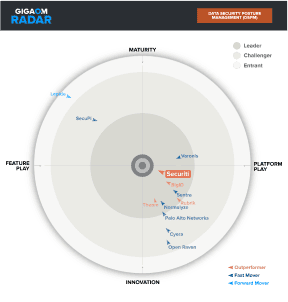Discovery & Classification
DSPM’s data discovery functionality helps security teams scan complex environments to identify data across a wide range of on-prem and cloud sources. The solution discovers data in public clouds, such as AWS, GCP, or OCI; private clouds, including MongoDB, Oracle, or SAP; data clouds like Snowflake or Databricks; and SaaS applications like Slack or Salesforce.
Data discovery alone isn’t enough to protect data accurately. DSPM’s data classification capability allows teams to categorize data using out-of-the-box AI-powered classifiers and, oftentimes, customized fields.
It classifies and labels data according to its sensitivity, such as confidential, public, or other types of data, or its regulatory context, such as protected health information (PHI), financial data, or personally identifiable information (PII).
Contextual Data+AI Intelligence
DSPM, with its centralized knowledge graph capability, brings together scattered data signals to offer actionable insights. It leverages tech stack integration, extensive data source connectivity, and contextual intelligence to provide a 360-degree view of data and AI.
For instance, it provides answers to questions such as which data is sent to streaming applications or AI models, which identities or roles access it, the security configurations, and the data's compliance posture.
Toxic Combinations of Risks
DSPM solution with a comprehensive knowledge graph can correlate diverse metadata attributes, enabling security teams to prioritize the detection of toxic risk combinations. Teams can create custom risk rules by considering the business context and application requirements.
This powerful capability of DSPM significantly improves the accuracy of risk identification, thereby reducing the number of false positives.
Security Posture Management
DSPM’s security posture management continuously scans cloud and SaaS configurations, classifies findings by severity, and shows where sensitive or regulated data could be at risk. Custom policies also allow for the enforcement of best practices, providing real-time alerts on any violations.
With ongoing monitoring of assets and configuration changes, DSPM enables proactive risk reduction, allowing security teams to effectively prioritize sensitive data risks and harden their cloud data security posture.
Related: How DSPM Reduces the Risk of Data Breaches
Data Access Intelligence & Controls
DSPM’s access intelligence and controls capability provides visibility into who has access to data (structured and unstructured) and who is accessing it. Teams can use these insights to detect access risks and enforce robust access controls. DSPM also provides fine-grained, policy-based entitlements across structured and unstructured data.
At the technical level, policies can be defined at the table, view, row, and column levels, allowing for highly precise privilege configurations, such as SELECT, MODIFY, or both. The dynamic column masking obfuscates sensitive fields, such as PII or financial data, in real-time, based on role or context, without blocking broader access to data for business use.
By combining access visibility, activity analysis, fine-grained enforcement, and privilege controls, DSPM solutions empower governance teams to manage data access with high precision.
Data Flow Intelligence & Governance
DSPM’s data flow intelligence automates data maps to demonstrate how data moves across systems and applications, is transformed, and interacts within environments. The solution does so through explicit and inferred lineage tracking, such as SQL parsing or dbt integration, as well as AI-powered techniques like data characteristic analysis, to track movement patterns and build relationships.
This comprehensive data lineage can help teams monitor how the data is accessed, used, changed, or transformed throughout its lifecycle. Teams can use these insights to identify gaps in the security and privacy aspects of the data, such as data duplication or cross-border transfers, and apply robust policies or controls.
ROT Data Minimization
DSPM’s ROT data minimization capability leverages policy-driven frameworks to help security and data teams overcome the risk of ROT data buildup. The solution helps create a comprehensive data catalog, labeling files based on signals like retention age, business context, or activity levels.
The solution also leverages advanced techniques, such as cluster analysis, to identify duplicate or near-duplicate data. With accurate classification, DSPM further highlights the data that might be violating any regulatory law or security standard.
AI Security & Governance
Modern DSPM solutions also offer robust AI security and governance capabilities as extended features. The built-in AI security capability helps teams scan the environment to discover cloud-native and shadow AI models and AI Agents.
The solution further provides context around data and AI interaction, highlighting risks such as hallucinations, exposure of sensitive data, model bias, and risky access permissions.
Some solutions may even offer advanced LLM firewall functionalities that filter AI inputs/outputs at various levels of interaction, including prompts, responses, and retrievals. These capabilities help secure Gen AI pipelines by filtering misinformation, malicious prompts, or PII phishing attacks.
Read more: Top 5 DSPM Use Cases for Optimal Data Security.
Compliance Automation
DSPM further simplifies compliance through automated, end-to-end workflows. It centralizes compliance tracking, testing, and reporting across global frameworks, using pre-built controls mapped to key regulations.
Features like automated compliance reporting, real-time monitoring, and Human-in-the-Loop attestation streamline evidence collection and validation. DSPM also factors in cross-border mandates, ensuring data sovereignty compliance at scale.
By unifying these efforts, organizations can reduce risk, lower overhead, and transform compliance from a reactive checkbox exercise into a proactive, business-enabling function.
DSPM streamlines remediation by combining automated responses with policy-based controls. The solution detects posture gaps across environments, prioritizes vulnerabilities by severity and impact, and applies automated fixes, such as fixing access permissions.
For higher-risk issues, DSPM integrates with tools like ServiceNow or Jira to trigger alerts and review workflows. This hybrid approach ensures efficient remediation without compromising stability, reduces risk exposure, and frees teams to focus on strategic security initiatives.
Seamless Integration with Enterprise Stack
DSPM solutions do not operate in silos, rather they are integrated into existing enterprise security stacks such as SIEM, CNAPP, CSPM tools. Seamless integration with a wide range of security tech stacks, such as SIEM tools, helps enterprises streamline their existing SecOps workflows, centralize monitoring and analysis, and enhance the efficacy of their security tools.
Breach Management
DSPM’s integrated breach response management capabilities can help identify sensitive data across the environment, map the data to individuals, and determine data breach notification requirements based on residency.
The solution can also automate remediation measures to respond to the breach immediately, such as encrypting exposed buckets, masking sensitive data, restricting access entitlements, and resolving misconfiguration issues.
Related: How DSPM Reduces the Risk of Data Breaches
What Data Security Tools Integrate Well With DSPM
To realize the full potential of DSPM, the solution must integrate with the existing enterprise security stack:
- IAM: Identity and access management (IAM) tools help enforce access controls, ensuring only authorized users can access sensitive data, while DSPM gives contextual insights into sensitive data and access risks.
- DLP: DLP can classify data with high accuracy to prevent sensitive data exfiltration and reduce false positives by integrating with DSPM solutions, while traditional DLP solutions rely on regex-based classification, which is not accurate.
- SIEM: Security information and event management’s (SIEM) ability to prioritize threat detection and response based on sensitive data insights can be greatly enhanced by DSPM's contextual data intelligence.
- CASB: Cloud access security brokers (CASB) provide visibility and control access to cloud infrastructure. DSPM offers insights into the data within the cloud data stores, such as data sensitivity and usage.
- IDPS: DSPM’s integration with tools like intrusion detection and prevention systems (IDPS) can greatly help with improved alert context, reduce false positives with precise threat detection involving sensitive data, and enable data-centric threat detection.
What is the difference between DSPM and CSPM?
The scope of CSPM is focused on identifying and remediating misconfigurations, vulnerabilities, and compliance violations in cloud infrastructure (such as virtual machines or containers). The solution scans the infrastructure against security frameworks like NIST, CIS, GDPR, and PCI DSS to find gaps and proactively remediate risks.















































